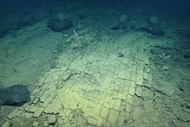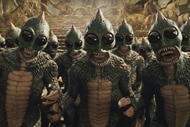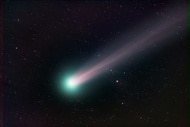Create a free profile to get unlimited access to exclusive videos, sweepstakes, and more!
Monstrous fossilized tooth may have belonged to hugest ichthyosaur ever
Sometimes, teeth are almost bigger than the mouth they're in.

The late Triassic and early Jurassic were no time to go to the beach — especially when the seas were swarming with things that were all teeth.
Ichthyosaur fossils don’t surface that often. After one enormous tooth was unearthed from what is now part of the Swiss Alps but used to be the bottom of an ocean 200 million years ago, it languished in the back room of a museum for years because more intact fossils emerged. Paleontologists Martin Sander, of the University of Bonn in Germany, and Heinz Furrer of the University of Zurich in Switzerland dug up those fossils again and realized what they had on their hands were the remains of what supposedly were the most monstrous ichthyosaurs.
If the owner of the tooth was as large as the only remnant it left behind indicated, it would have been at least 60 feet long and one of the largest animals ever to live in the sea or land. It would have been right up there with that mosasaur that devoured a T. Rex in Jurassic World: Fallen Kingdom. That isn’t impossible. However, another possibility is that the tooth belonged to a smaller (though no less dangerous) ichthyosaur that happened to have a mouthful of outsized teeth ready to tear at flesh. Sander and Furrer led a study recently published in Journal of Vertebrate Paleontology.
“Strange grooves in the tooth are the surface expression of a complex internal structure, sort of an infolding of the material of the root, or dentin,” Sander told SYFY WIRE. “It is not really clear what the infolding is good for, but it certainly is diagnostic of ichthyosaurs.”
This tooth probably survived because it was harder than the vertebrae and ribs that were found along with it decades ago. Those were the only relics Sander and his team had to go off of when trying to figure out how huge a beast with a tooth that size had to have been, if the size of the tooth really did match the size of the ichthyosaur it came from. Fragments of vertebrae and ribs found at the same site (which were from other ichthyosaurs) were compared to a more complete skeleton from another museum. It turned out that the larger vertebrae and ribs were close to those of the other skeleton, but there was a problem. That skeleton was toothless.
Without teeth, there was no way to see whether a bigger bite meant a bigger ichthyosaur. Sander recently studied the 6-foot skull of another huge specimen, thought to be about 58 feet, and its teeth were only about 8/10 of an inch at the base. That is nothing compared to the 2.4 inch base of this menacing tooth. If this reptile was scaled to match its teeth, then it would have been so bulky that it might have had trouble getting around and snapping up prey. Sperm whales are predators that reach about 60 feet and have teeth that size.
“The tooth indicates a predatory lifestyle, which carries a lower limit to body size than bulk feeding on plankton and small invertebrates,” Sander said. “If you feed high in the food chain, there is less energy available than low in the food chain, limiting body size.”
An ichthyosaur oddly would have been much better off with a more streamlined body that allowed it to chase after what it wanted to sink its teeth into. This is why the most massive extant creature, the blue whale, is such a behemoth compared to the sperm whale. Blue whales only look like they could swallow just about anything in the ocean whole. They feed on plankton and small invertebrates as they swim languidly through the deep, while sperm whales hunt everything from fish and squid to entire sharks. Yes, sharks actually do have something to be afraid of.
The ichthyosaur would have been about the same size as that mosasaur in Fallen Kingdom at 60 feet. The largest known mosasaur skeleton is 56 feet long. If Sander could compare a killer ichthyosaur’s lifestyle to anything alive now, it would have to be a carnivorous whale.
“The giant ichthyosaurs lived further offshore than the habitat that is represented by the deposits the tooth was found in,” he said. “They must have had a lifestyle much like today’s large toothed and baleen whales.”
Whether or not this sea monster was the most immense one that ever lived, its tooth is still the largest ichthyosaur tooth ever found. Take a bite out of that.



























